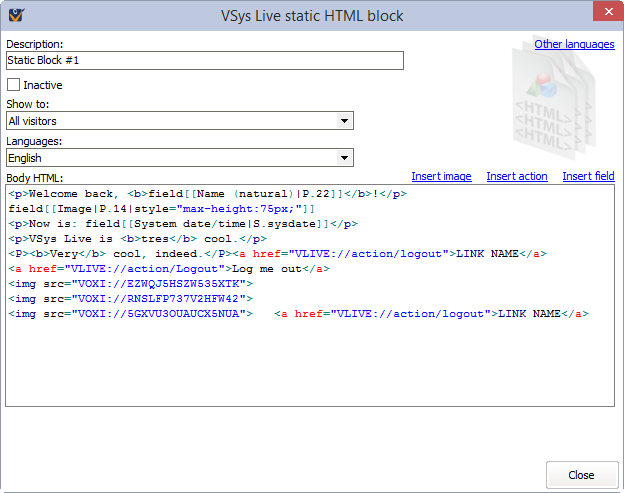Static HTML blocks are blocks that you design and which can be placed into regions on any page. They're not "smart" in that they can't apply business logic by calling VOXI and they don't contain Ruby code but they're easy to use and a way for you to put your own content on any page.
Define any number of static HTML blocks and for each set the Description (this is not displayed to visitors), whether it's valid for logged-in or anonymous (not-logged-in) visitors and the appropriate languages. VSys One doesn't constrain the content that you can put into a static HTML block. It doesn't understand what you're entering here, it just passes it to VSys Live for inclusion on pages.
Use the Insert image and Insert action links to insert VSys Live images and/or actions. These enter special URLs that VSys Live understands and can validate. VSys One won't let you save a static HTML block that contains VOXI:// or VLIVE:// elements that it knows aren't valid. For external images (those not defined in VSys), you can manually enter your own <img> tags. You can also add things like IFRAMEs or pretty much anything else. VSys One won't validate that what you enter is legitimate, you have to know and test that yourself.
If present, use the Insert field link to insert one or more data fields into the block. Note that some fields may not be available if the website visitor isn't logged in. When rendered in a visitor's web browser, VSys Live will try to resolve these fields and insert their content in place of the field specifications.
For inserted fields which are images, you can manually include parameters in the link to adjust the size or other properties of the resulting image. For example, inserting a person's photo puts field[[Photo|P.14]]
into the block. If the person has a photo, this generates the HTML <IMG SRC="/CACHE/XYZ" alt="Photo"/>
Changing the field to field[[Photo|P.14|height="50"]]
would generate <IMG SRC="/CACHE/XYZ" alt="Photo" height="50"/>